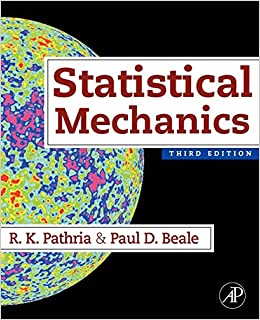Let us concentrate on one particular spin, (mathrm{s}_{0}), in the lattice and look at the part of
Question:
Let us concentrate on one particular spin, \(\mathrm{s}_{0}\), in the lattice and look at the part of the energy \(E\) that involves this spin, viz. \(-2 J \sum_{j=1}^{q} \mathbf{s}_{0} \cdot \mathbf{s}_{j}-g \mu_{B} \mathbf{s}_{0} \cdot \mathbf{H}\); for notation, see Secs. 3.9 and 12.3. In the spirit of the mean field theory, we replace each of the \(\mathbf{s}_{j}\) by \(\overline{\mathbf{s}}\), which modifies the foregoing expression to \(-g \mu_{B} \mathbf{S}_{0} \cdot \mathbf{H}_{e f f}\), where
\[
\begin{equation*}
\mathbf{H}_{\text {eff }}=\mathbf{H}+\mathbf{H}^{\prime} \quad\left(H^{\prime}=2 q J \overline{\mathbf{s}} / g \mu_{B}\right) . \tag{1}
\end{equation*}
\]
We now apply the theory of Sec. 3.9. Taking \(\mathbf{H}\) (and hence \(\overline{\mathbf{s}}\) ) to be in the direction of the positive \(z\)-axis, we get from eqn. (3.9.22)
\[
\begin{equation*}
\bar{\mu}_{z}=g \mu_{B} s B_{s}(x) \quad\left[x=\beta\left(g \mu_{B} s \right) H_{e f f}\right] \tag{2}
\end{equation*}
\]
where \(B_{s}(x)\) is the Brillouin function of order \(s\). At high temperatures (where \(x \ll 1\) ), the function \(B_{s}(x)\) may be approximated by \(\{(s+1) / 3 s\} x\), with the result that
\[
\begin{equation*}
\bar{\mu}_{z} \approx \frac{g^{2} \mu_{B}^{2} s(s+1)}{3 k T}\left\{H+\frac{2 q J \bar{\mu}_{z}}{g^{2} \mu_{B}^{2}}\right\} \tag{3}
\end{equation*}
\]
The net magnetization, per unit volume, of the system is now given by the formula \(M=n \bar{\mu}_{z}\), where \(n(=N / V)\) is the spin density in the lattice. We thus get from (3)
\[
\begin{align*}
& M\left(1-\frac{T_{c}}{T}\right) \approx \frac{C H}{T}, \text { i.e. } M \approx \frac{C H}{T-T_{c}}, \text { where } \tag{4}\\
& T_{c}=\frac{2 s(s+1) q J}{3 k}, C=\frac{n g^{2} \mu_{B}^{2} s(s+1)}{3 k} . \tag{5}
\end{align*}
\]
The Curie-Weiss law (4) signals the possibility of a phase transition as \(T \rightarrow\) \(T_{c}\) from above. However, this is only a high-temperature approximation, so no firm conclusion about a phase transition can be drawn from it. For that, we must look into the possibility of spontaneous magnetization in the system.
To study the possibility of spontaneous magnetization, we let \(H \rightarrow 0\) and write from (2)
\[
\begin{equation*}
\bar{\mu}_{z}=g \mu_{B} s B_{s}\left(x_{0}\right) \quad\left[x_{0}=\beta\left(g \mu_{B}s \right) H^{\prime}=2 s q J \bar{\mu}_{z} / g \mu_{B} k T\right] . \tag{6}
\end{equation*}
\]
In the close vicinity of the transition temperature, we expect \(\bar{\mu}_{z}\) to be much less than the saturation value \(g \mu_{B} s\), so once again we approximate the function \(B_{s}\left(x_{0}\right)\) for \(x_{0} \ll 1\). However, this time we need a better approximation than the one employed above; this can be obtained by utilizing the series expansion
\[
\operatorname{coth} x=\frac{1}{x}+\frac{x}{3}-\frac{x^{3}}{45}+\ldots \quad(x \ll 1)
\]
which yields the desired result:
\[
\begin{equation*}
B_{s}(x)=\frac{s+1}{3 s} x-\frac{(s+1)\left\{s^{2}+(s+1)^{2}\right\}}{90 s^{3}} x^{3}+\ldots \quad(x \ll 1) . \tag{7}
\end{equation*}
\]
Substituting (7) into (6), we get
\[
\begin{equation*}
\bar{\mu}_{z}=\frac{T_{c}}{T} \bar{\mu}_{z}-\frac{b}{g^{2} \mu_{B}^{2} s^{2}}\left(\frac{T_{c}}{T} \bar{\mu}_{z}\right)^{3}+\ldots \tag{8}
\end{equation*}
\]
where \(T_{c}\) is the same as defined in (5), while \(b\) is a positive number given by
\[
\begin{equation*}
b=\frac{3}{10}\left\{1+\frac{s^{2}}{(s+1)^{2}}\right\} \tag{9}
\end{equation*}
\]
Clearly, for \(T
\[
\begin{equation*}
\bar{\mu}_{z} \approx\left(g \mu_{B} s / \sqrt{b}\right)\left(1-T / T_{c}\right)^{1 / 2} \tag{10}
\end{equation*}
\]
The long-range order \(\bar{L}_{0}\) is then given by
\[
\begin{equation*}
\bar{L}_{0} \equiv \bar{\mu}_{z} /\left(g \mu_{B} s\right) \approx(1 / \sqrt{b})\left(1-T / T_{c}\right)^{1 / 2} \tag{11}
\end{equation*}
\]
For \(T \ll T_{c}\), we employ the approximation
\[
\begin{equation*}
\operatorname{coth} x \approx 1+2 e^{-2 x} \text {, whence } B_{s}(x) \approx 1-s^{-1} e^{-x / s} \quad(x \gg 1) \text {. } \tag{12}
\end{equation*}
\]
Equation (6) now gives
\[
\begin{equation*}
\bar{L}_{0} \approx 1-s^{-1} \exp \left(-\frac{2 s q J}{k T}\right)=1-s^{-1} \exp \left\{-\frac{3 T_{c}}{(s+1) T}\right\} \text {. } \tag{13}
\end{equation*}
\]
For \(s=1 / 2\), expressions (11) and (13) reduce precisely to eqns. (12.5.14 and 15) of the Ising model; the expression for \(T_{c}\) is different though.
Step by Step Answer:






